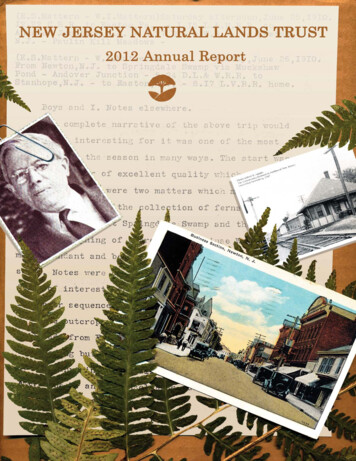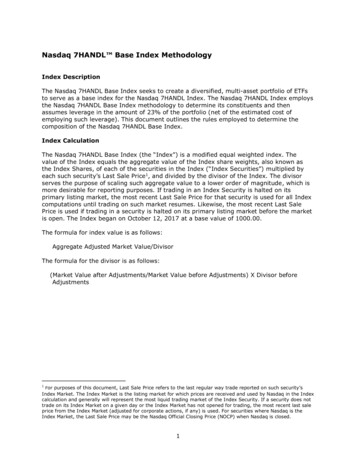
Transcription
Statement of PurposeThe New Jersey Natural Lands Trust was created bythe Legislature in 1968 as an independent agencywith the mission to preserve land in its natural statefor enjoyment by the public and to protect naturaldiversity through the acquisition of open space.The Trust preserves land primarily by donations ofopen space through acquisition of title in fee simpleor of conservation easements, and manages its properties to conserve endangered species habitat, rarenatural features, and significant ecosystems. TheTrust invites passive use by the public for recreational or educational purposes wherever such usewill not adversely affect ecological communitiesand biological diversity.The Trust also recognizes that ownership and management alone are not enough to achieve its mission. Public education is an integral function ofprotecting natural diversity. The Trust distributesinformation designed to convey a conservationethic for the protection of open space and its naturalvalues.New Jersey Natural Lands Trustcontact information:New Jersey Natural Lands TrustMail Code 501-04P.O. Box 420Trenton, NJ 08625-0420Phone (609) 984-1339Fax (609) 984-1427Email: NatLands@dep.state.nj.uswww.njnlt.orgCover Photo Credits/Captions:Harold W. Pretz Photo Credit: Courtesy ofPhiladelphia Botanical ClubAndover Junction RailroadStation Photo Credit: Robert B. AdamsVintage Postcard of Spring Street, Newton, NJ.The Hotel Waldmere is the white buildingin the center, left side.Cover Design Credits: David Snyder andRoman SenykIndex of Preserves ReferencedWithin the 2012 Annual ReportAtlantic CountyBearshead Preserve 1Clarks Landing Preserve 1Hamilton Preserve 4Camden CountyPetty’s Island Preserve 5, 6Four Mile Branch Preserve 1Gloucester CountyRaccoon Creek Preserve 1Hunterdon CountyHagedorn Preserve 1, 2, 3Sweet Hollow Preserve 1Thomas F. Breden Preserve at Milford Bluffs 1, 15Ocean CountyCrossley Preserve 1Mystic Island Preserve 1Warren CountyBear Creek Preserve 1Limestone Ridge Marsh Preserve 15Sussex CountyPaulinskill River Greenway Preserve 8 - 14
In 2012.the New Jersey Natural Lands Trust brought approximately 530 new acres under Truststewardship, making the Trust responsible for over 27,000 acres managed as a system of more than 120preserves throughout the state.The acquisitions represented additions to the Bear Creek, Bearshead, Clarks Landing, Crossley, Four MileBranch, Hagedorn, Mystic Island, Raccoon Creek and Sweet Hollow preserves and the Thomas F. BredenPreserve at Milford Bluffs.Bear Creek Preserve Got Biggern 2012 the already big, 650-acre Bear CreekPreserve located in Allamuchy and FrelinghuysenTownships, Warren County got bigger. Fiftypercent bigger! At over 1,000 acres it is now theTrust’s fourth largest preserve, following the Crossley,Hamilton and Great Piece preserves.IThe new acreage came in the form of two separateacquisitions—one from the Presbyterian Camp andConference Center and the other from The NatureConservancy. The Trust, partnering with the NewJersey Green Acres Program, preserved 115 acres of thePresbyterian Camp and Conference Center’sJohnsonburg Camp. To help Green Acres with theacquisition, the Trust obtained 300,000 in grant moneyfrom the US Fish and Wildlife Service under Section 6of the Endangered Species Act’s Recovery LandAcquisition Program forthe preservation of highquality bog turtle habitaton this property. Inaddition to providing bogturtle habitat, thisproperty also provideshabitat for a number ofrare plants including thestate-endangeredspreading globe flower,small bedstraw andLabrador marsh bedstraw.In the second acquisition,The Nature Conservancygenerously donated its200-acre Glovers PondPreserve to the Trust. InFall foliage in the limestoneaddition to providing aforest at the Bear Creek Preserve.variety of habitats-Photo Credit: Martin Rappforested floodplain alongthe Bear Creek, rich meadow marsh, spring-fedwetlands at the base of a limestone ridge, and limestoneforest, unique to the Ridge and Valley Region of NewJersey--the Glovers Pond Preserve serves as animportant link for over 1,000 acres of preserved land,thereby enhancing habitat connectivity important forspecies such as bog turtle, wood turtle, barred owl andbobcat.Prior to this year’s additions, the Bear Creek Preservealready included portions of two Natural HeritagePriority Sites (Luse Pond and Southtown Sinkhole),which are important areas for supporting New Jerseybiodiversity. The Johnsonburg Camp acquisition helpsprotect yet a third Natural Heritage Priority Site-Glovers Pond--which hosts a rare plant communityassociated with the adjoining limestone fen.Pond habitat at the Bear Creek Preserve.Photo Credit: Martin RappAlthough there are no maintained trails at this time, theBear Creek Preserve is open to the public. Its visuallystunning Franklinite marble and limestone rock outcrops and mix of habitats make Bear Creek a veryinteresting and enjoyable place to visit.1
Happenings at the Hagedorn PreserveFor years the Hagedorn Preserve has been one of the Trust’ssleepier preserves--there had been no new additions, nosignificant management concerns, and no big policy issues atthis preserve. What a difference a year makes.The New Year started out with a bang in the form of a newaddition to the Hagedorn Preserve. In January 2012 the NewJersey Department of Human Services (DHS) transferred aseven-acre property known as Barren Run to the Trust.Although not immediately adjacent to the heart of thepreserve, it is a nice forested property that adds to thesurrounding contiguous forest and serves as habitat to bobcat, barred owl, eastern box turtle, wood thrush and veery.Situated in the Highlands Preservation Area, the forest at theHagedorn Preserve serves as important core forest habitat(defined as greater than 300 feet from altered land or a road).Conservation of large tracts of contiguous core forest habitatand minimization of fragmentation were identified as majorissues of concern in the New Jersey Highlands by the USDAForest Service in 2002. So, while small, this new additionhas significant ecological value.Then, during the 2012 annual budget address, GovernorChristie announced his decision to close the Senator GarrettW. Hagedorn Psychiatric Hospital, the Trust’s long timeneighbor, by June 30, 2012. The Trust’s new neighbor wouldbe Veterans Haven North, a 100-bed transitional livingprogram for homeless veterans. While this change does notdirectly affect the preserve, the Trust had enjoyed a goodworking relationship with the staff of the hospital regardingmaintenance issues. We look forward to getting to know andworking with our new neighbor.Members of Trust Board consider area of conceptual quarry expansion proposal. Photo Credit: Steve Eisenhauer2
In late spring another neighbor, US Concrete, contacted theTrust regarding a conceptual proposal to swap 30.5 acres ofthe Hagedorn Preserve in exchange for a compensation andrestoration package that included financial payments to theTrust, long-term restoration of Trust property, as well as thetransfer to the Trust of 152.7 acres located in HardystonTownship, Sussex County within the Wallkill River NationalWildlife Refuge. US Concrete attended the Trust’s June2012 meeting and expressed concern that its quarry creates apotential public hazard due to existing high benches andsteep slopes created by the previous owner, Pinnacle. Inorder to mitigate the hazardous slopes, it proposed to expandits quarry into the Hagedorn Preserve in the area of the Mt.Kipp summit. After the Board raised a number of complexpolicy and practical questions, Chairman Catania indicatedthat this conceptual proposal should be considered by aCommittee which would provide recommendations to theBoard. The Committee spent the summer months reviewingthe conceptual proposal and visiting the quarry and proposedreplacement lands.At the Trust’s September meeting, the Committee reportedits preliminary finding to the full Trust Board that USConcrete’s conceptual proposal did not appear to adequatelydemonstrate that there were no reasonable alternatives tomining Trust property, as required by the Trust’s Guidelinesfor Conveyance of Land. For this reason, the Committeerecommended that the Trust discourage US Concrete fromsubmitting a conveyance application.Although US Concrete did not submit a formal application,the Trust received public opposition to the news of theconceptual proposal, including letters opposing theapplication from both Lebanon Township and Glen GardnerBorough. There were negative portrayals of the conceptualproposal in the press. Glen Gardner’s attorney, the Directorof Policy for the Raritan Headwaters Association and severallocal residents attended the Trust’s September 2012 meetingto oppose US Concrete’s conceptual proposal based uponconcerns about potential adverse impacts to water quality,endangered species habitat and the viewshed. The Trust hasassured the public that if an application is submitted, itsstringent Guidelines for Conveyance of Land will befollowed, and that any public meetings about the applicationwill take place in either Glen Gardner Borough or LebanonTownship, not in Trenton.As just one preserve in a system of more than 100 preserves,and without many management issues, it was easy for theTrust to overlook the importance of the Hagedorn Preserveover the past few years. As a result of the US Concreteproposal, the Trust has taken a fresh look at this Highlandspreserve and has been reminded of its significance as criticalhabitat for rare animal species and for water quality, as wellas being a beautiful viewshed enjoyed by the surroundingcommunity.Members of the Board and others walking a Hagedorn Preserve trail. Photo Credit: Steve Eisenhauer3
Stumped on Public AccessOne of the primary objectives of the Trust is public access tothe landscapes and rich natural resources in its system ofpreserves across New Jersey.between the two biggest stumps.Unfortunately, sometimes public access also means anopportunity to dump debris and refuse. It may also meanrepeated and relentless damage caused by unauthorizedoff-road motorized vehicles--including big trucks, ATV’s andmotorcycles--to sensitive habitats for plants and animals.One person’s favorite hunting or fishing spot can becomeanother person’s illegal playground. Signs installed by theTrust’s land manager prohibiting dumping or motorizedvehicle access are often torn down as soon as they areposted.It did! At least for a while.But would it work?It is easy to imagine how it happened. One evening, afterdark, using chains and cables lashed to their 4x4 trucks, theytugged until a breach in the barricade again allowed illegalaccess. Gate locks were cut and signs torn down.The Trust will be persistent in maintaining its investment. Itplans to repair the barrier and gate, replace the signs, andstrive to keep this public land open and available for worthyand appropriate public enjoyment.In the spring of 2012, after numerous phonecalls to report dumping of constructiondebris in the Trust’s Hamilton Preserve,including two discarded motor boats stafftook action in a bold way.Following Hurricane Irene in 2011, fallentrees, stumps and root balls were in no shortsupply. The thought was to establish abarrier to trucks and ATVs, a massiveembankment created entirely of treestumps-- stacked and packed so closetogether as to prevent access to trucks oreven block menacing ATVs. The NJDepartment of Environmental Protectiondetermined that use of stumps for thispurpose would be an adaptive reuse of anatural product. It was worth a try.Several local contractors bid on the job andprovided valuable insight on how to goabout the task. Local excavator Fred Puggiwas selected and quickly got to workstockpiling load after load of tree stumps onthe site. Then, using an excavator and awheeled loader, moved each stump intoposition, creating a seemingly impenetrablebarricade along the entire road frontage(1,500 feet in length). After completing thestump barricade, the site hopefully nowsecured from further dumping, the excavatoralso removed debris, boats and trash fromthe preserve, filling a 30-yard dumpster.Signs were reposted making it clear thatdumping and ATV use were prohibited. Agate for management access only was secured4One of many loads of stumps brought in to help prevent dumping and other forms ofillegal access to the Hamilton Preserve. Photo Credit: Martin Rapp
Petty’s Island UpdateThe Trust is pleased to report a very successful and excitingfirst year of educational programming at Petty’s Island underits contract with New Jersey Audubon Society (NJAS) andits two subcontractors, the Delaware RiverKeeper Networkand the Cooper River Watershed Association. Under thiscontract, hundreds of people were provided access to Petty’sIsland as participants in a wide variety of programs. NJASled trips for three different Camden and Pennsauken highschool groups, supervised two volunteer clean-ups and led anumber of trips open to the general public focused on thehistory of the island and its natural resources. Based on itsfirst year’s success, the Trust awarded NJAS the contract foranother year. Similar but expanded programming isexpected for 2013.To help the Trust develop a broad and expansiveinterpretation of the island’s cultural and natural resources,NJAS is reaching out to local community groups and othersto participate in an Education Advisory Group. It is hopedthat this group will provide input on any number ofeducational and interpretive issues, including programmingopportunities and the development of the topics andmessages for interpretive wayside exhibits.Decades ago a road circumnavigated the island’s perimeter.A portion of this old road has been cleared by Trust Boardmembers, staff and other volunteers to create a trail to thesouthernmost point of the island where views of thePhiladelphia skyline are spectacular. In October the WilliamPenn Foundation awarded the Trust a grant of 82,500 toexpand and restore trails on Petty’s Island and to produceand install interpretive exhibits at key locations along trailsto interpret the historic and ecological significance ofspecific elements of the island identified in the Trust’s VisionPlan. The exhibits will include QR codes accessible by codereader applications on phones and mobile devices linkingvisitors to additional material such as recorded messagesfrom diverse stakeholders.Buck surveying Petty’s Island’s industrial landscapePhoto Credit: Cari WildRed tail hawk ruling from his perch upon a light fixture at Petty’sIsland Preserve. Photo Credit: Cari Wild5
In 2012 the Trust took some big steps towards afuture cultural and education center planned for theisland. Using the William Penn Foundation grant,the Trust hired Lammey & Giorgio, an architectural,planning, project management and facilitiesmanagement firm, to conduct a feasibility analysisof potential center locations and produce conceptualcenter designs. The Trust plans to convene anotherstakeholders meeting in 2013 to share Lammey &Giorgio’s findings and designs and to seek input onthe direction of the center.Beyond the exciting developments related toeducational programming and a future center, thereal story at Petty’s Island is how plants and animalsare thriving in the midst of an industrial landscapelocated in a highly urbanized area. All kinds ofcritters make themselves at home on the island—bald eagle, deer, fox, osprey, American kestrel,red-tailed hawk, great blue heron, black-crownednight heron and more—and do not seem troubled bytanks, poles, lines and other structures. Theglobally rare water marigold is found on the islandas well as numerous other rare plants and ecologicalcommunities. As the oil storage tanks and otherstructures are razed and the island is remediated,even more critical habitat will be created, makingthe island even better suited to support New Jersey’snative biodiversity.Osprey enjoying the catch of the day.Photo Credit: Jack McCrossin6Jack McCrossin regaling Chairman Catania and William Penn Foundationstaff with tales of Petty’s Island. Photo Credit: Cari WildFox kit playing in some ready-made toys. Photo Credit: Jack McCrossin
Baselines and Easements: Volunteers Take the Field NotesA long held, standard rule of responsible management ofconservation lands is get out on the land and see it foryourself. See what is there, what changes are taking place,what changes have taken place since the previous visit. Arethere noteworthy indications of changes in the naturalsurroundings, wildlife movement patterns, habitat successionor other observations? When you are familiar with alocation after repeated visits, over multiple years, yourobservations begin to show a pattern and tell a story.Documenting and recording those important observationsand changes form a written history of the site, a lastingrecord for long-term reference. Initial visits establish thepreserve baseline, and follow-up visits overtime create a record of change; an organizedway for you or others to peer back thoughtime or to plan for the future. Field notes aswell as photographs and sketches allowothers to compare or contrast your observations with those during a later visit. Once apreserve baseline is established, landmanagers can avoid depending on dimmingrecollections or mixed up memories andhearsay.Establishing a preserve baseline seemsstraight forward enough. However,exercising good field note taking skills andfiling the gathered data in an organizedreference system is often relegated to thegrowing to-do pile of never ending paperwork. “My to-do pile has grown like aweed.” said Trust Preserve Manger, MartinRapp. To create and update the Trust’spreserve baselines we asked volunteer PeterRevilla to help. Peter has an EnvironmentalStudies degree from Stockton State Collegeand is employed as an environmentalconsultant and project manager forenvironmental remediation. He has ademonstrated commitment to environmentalwork that improves his community. Thatdirected commitment led him to volunteerfor the Natural Lands Trust. Peter acceptedthe challenge to update our preserve baselinemonitoring forms which help standardize theinformation gathered during preserveinspections. Peter is moving ahead withinspections of each of the Trust’sconservation easements. He has alreadyvisited several easements and created thewritten and photographic records necessaryto establish a solid baseline for futuremonitoring. This baseline data is importantin case encroachments or violations occur on ourconservation easements or preserves.Peter has made helpful recommendations and continues towork independently to complete our overall inspectionrequirements. Staff has found working with Peter to be veryeasy, and his schedule for volunteering on weekends andevenings has resulted in much more work beingaccomplished. The Trust owes a big thank you to Peter andother volunteers and helpers who work to keep the NaturalLands Trust’s statewide systems of preserves an accuratelydocumented resource for people and wildlife.Volunteer Peter Revilla provides the Trust with invaluable baseline developmentand easement monitoring. Photo Credit: Leslie Revilla7
FEATURED GUEST ARTICLE:The Botanical Mythology of the Paulins Kill Meadows, New JerseyDavid SnyderDepartment of Environmental Protection, State Forestry Services,Office of Natural Lands Management, Natural Heritage ProgramA great many interesting new finds are yet in store for the botanist who has the opportunity to spend moretime about Newton where Nature is still quite undisturbed in many places.Phillip Dowell, Fourth Annual Botanical Symposium of 1907Everything changes and nothing remains still . and . you cannot step twice into the same stream.Heraclitus, as quoted by PlatoIt has been said that it is the unexpected that happens, and in so far as we are unprepared for some events, this is true.Harold W. Pretz, 1911Harold W. Pretz, an Allentown, Pennsylvania banker byprofession, was by avocation a field botanist who spentmuch of his nearly 96 years studying the flora of easternPennsylvania and adjoining New Jersey. He became theleading expert on some of New Jersey’s most importantbotanical sites, including the site that he and the otherbotanists of the time called the Paulins Kill Meadows,located just northeast of Newton, in mostly Andover andHampton townships, Sussex County.Late in the afternoon of June 25, 1910, Pretz wandered alongthe edges of the Sussex Branch of the Delaware Lackawanna& Western Railroad that sliced through the eastern edge ofthe Paulins Kill Meadows looking for unusual plants andbirds. He had parted from his traveling companions, theMattern brothers, Ned and Walter, at the Newton railroadstation on Spring Street—they to make overnight arrangements at the nearby Hotel Waldmere, he to get a jump on hisbotanical explorations. His interest in the Meadows was perhaps piqued by all the rare and unusual plants that had beendiscovered there during the Botanical Symposium convenedat the Hotel Waldmere in 1907. The attendees1 of theSymposium, a week long joint meeting of members of thePhiladelphia Botanical Club, the Torrey Botanical Club andothers, were the first to document in a comprehensive waythe diverse flora of the Meadows.By the time the brothers (or the “boys” as he called them)rejoined Pretz, he had located few previously undocumentedplants, but did make note of having heard the calls of “therails and marsh wrens.” The goal for the afternoon was toinvestigate the flora of theMeadows, especially in theareas he called the “TamarackSwamp” and the “CranberryBog,” located about equidistantbetween the Newton railroadstation and the next station tothe north at BranchvilleJunction. As the small partywalked northeastward, Pretzrecorded the presence of two ofNew Jersey’s pink-floweredorchids, the grass pink and therose pogonia, observing, “Thelater was about past but the former in best condition, abundantand beautiful.”Grass pink orchid.Photo Credit: David SnyderOn Decoration Day, a few weeks earlier, Pretz and theMatterns, had discovered in the Meadows another one ofNew Jersey’s pink orchids. This species, Arethusa or dragonmouth, is a rare plant known primarily from sphagnous bogsin the Pine Barrens and all but unheard of from northernNew Jersey locations. Several other rare New Jersey plantspecies were observed by Pretz on that earlier day in May:Andromeda2 (or bog rosemary), bog birch, bog willow,buck-bean, and others. Also found were a number of “SouthJersey” plants like golden club, large cranberry and pitcherplant. Although not rare, these species are all more characteristic of New Jersey’s Coastal Plain, especially the PineBarrens. But here, in peaty pools and on sphagnous1- The attendees were a who’s who of botanical luminaries: from professional botanists such as Nathaniel Lord Britton, author of the first comprehensive flora of NJ and the first director of the NY Botanical Garden, to accomplishedamateurs like Bayard Long, the acknowledged expert on the flora of southern NJ. (Long was independently wealthy—his father wrote the short story that was the basis of the libretto of Puccini’s Madame Butterfly—so he was ableto devote his life to documenting the local flora.)2- This small woody shrub in the blueberry family was named for the Greek princess Andromeda in 1753 by the Swedish botanist Carl Linnaeus. Andromeda, in Greek mythology, had been chained to a coastal rock as a sacrifice forher mother’s boastful indiscretion and just before she is swallowed by Poseidon’s sea serpent she was rescued by Perseus, her future husband. A literal translation is “to be mindful of men.”8
hummocks in the dim light of tamaracks, they grew side-byside with their displaced northern brethren, plants whichwere relicts of geographical distribution from the last iceage.As the day drew to a close on the group’s most recent exploration of the Meadows, a hurried retreat was made to returnto the Waldmere so as not to miss supper. No new rare plantshad been discovered on that day and even the detour to lookfor eggs in the nest of the marsh hawk (now named thenorthern harrier), was unlucky (the nest was empty) but theydid see a bittern and several sora (a small elusive marshbird)as they walked back along the railroad.The next day, June 26, 1910, Pretz and the Matterns were ontheir way by 7:00 AM, walking from Newton to Springdaleby way of Muckshaw Ponds. This day’s mission was tocollect various species of shield ferns at the “Big Spring” forstudy by Phillip Dowell,3 the leading expert on this difficultgroup of ferns. Reaching the spring, they paused for a drinkbefore getting on with their fern collecting. They spentseveral productive hours searching among the bewilderingarray of the promiscuous shield ferns. Mission completed,they made the hike from the swamp to the Andover Junctionrailroad station for their return home, lugging theirover-filled plant presses (102 fronds of the ferns alone),bulky photographic equipment, and whatever luggage theycarried; their clothes and shoes covered in the muck and mireof the day’s work.Upon reaching the depot, the station master directed theirattention to a stranger “which he ventured must be in thesame business as [they] were.”(Translation: he was also filthy.)The stranger was Kenneth KentMackenzie, a New York City attorney, and one of the most knowledgeable field botanists that NewJersey has produced (KKM lived inMaplewood, New Jersey).Mackenzie had spent the day collecting unusual sedges from thelimestone swamps, lakes shores,sinkhole ponds and wooded ridgesalong the Sussex Branch, north ofPitcher Plant, more characteristic of New Jersey’s Andover Junction. It was NedCoastal Plain, but found at Mattern who first approachedPaulins Kill Meadows. Mackenzie and asked in the awkPhoto Credit: ward colloquialism of the timeDavid Snyder“what luck” had he that day. A con-versation ensued, notes compared, and the day’s botanicaldiscoveries discussed and thencontinued onboard the train untilthey parted company at theStanhope railroad station.Andromeda also known as bogrosemary.In 1913, Mackenzie made hisPhotoCredit:DavidSnyderfirst field trip to the Paulins KillMeadows; perhaps inspired bythat chance meeting with Pretz and company, three years earlier. He returned once more in 1914. Mackenzie observedmost of the rare plants documented by Pretz and the earlierbotanists and discovered several previously unreportedspecies. At the time, Mackenzie was well on his way toestablishing himself as the leading expert of the notoriouslydifficult sedge genus, Carex, and he recorded several goodfinds including soft-leaf sedge, livid sedge (common in peatlands in the Pine Barrens but exceptionally rare in northJersey) and the relocation of the mud sedge, then knownonly from three or four New Jersey locations.Between 1907 and 1914, a total of 24 rare or regionallyuncommon plant species had been documented from variouslocations within the Paulins Kill Meadows through the fieldwork of the botanists of the Symposium, Pretz, andMackenzie.Harold Pretz died November 8, 1973 and is all but unknownto today’s generation of field botanists. If not for the ca.16,000 plant specimens that he pressed, mounted and giftedto several local botanical institutions his discoveries wouldbe lost.4 Mackenzie, (whose considerable botanical achievements are recognized far more today than had been duringhis lifetime), born in the same year as Pretz (1877), died in1934. Botanically, the Mattern brothers,5 have been relegatedto obscurity—they made no New Jersey botanical collectionsnor have they left behind any field notes that I’m aware of.Although they made significant botanical discoveries, onlyPretz seems to have made note.After fighting a losing ridership battle to the automobile, theSussex Branch of the D.L. & W. Railroad, which hadprovided the early naturalists easy access to the Meadows,ended all rail passenger service October 2, 1966. A few yearslater, in November of 1970, the historic Newton passengerstation was torn down. The Andover Junction station burnedto the ground 20 years earlier. The last of the rails werepulled up in 1977.3- Dowell, who was an old friend of Pretz (they met when Dowell taught at Muhlenberg College in Allentown), described several new shield fern hybrids, two of which were discovered by him at the Big Spring during the 1907Newton Symposium.4- Even the plant species discovered by and named for Harold Pretz (Polygala pretzii) is now regarded as too trivial, and has been discarded into the waste bin of botanical synonymy.5- Robert L. Schaeffer, Jr. (who was a field companion of Pretz) told me that Walter Mattern had a heart condition and soon stopped going out in the field with Pretz, turning to painting instead. He was a close friend of the impressionistic painter Walter Baum (founder of the Baum School of Art). Mattern’s impressionistic paintings are in the collection of several major art museums. He died in 1946. Several years after his 1910 Paulins Kill Meadows trip withPretz, Edwin “Ned” Mattern, moved to West Point, PA where in 1918 he bought a feed store. A year earlier, he was assigned a U.S. patent for a machine that cut seed potatoes. His date of death is given as “?” on one online familytree.9
The Hotel Waldmere had maintained at least a tangentialnatural history connection by hosting into the 1970s some ofthe annual meetings of the Sussex County Bird Club.6 In theyears that followed, the hotel changed names and ownershipa number of times and in 2012 it closed its doors under thename JC’s Grill House.The land fared less well.The Paulins Kill Meadows has its origin in the glaciermeltwater that was trapped by the surrounding hills.Throughout the Holocene the glacial lake that had formedfilled with sediments and decomposing plant debris (mostlymoss, sedge and grass species). The resul
Presbyterian Camp and Conference Center's Johnsonburg Camp. To help Green Acres with the acquisition, the Trust obtained 300,000 in grant money from the US Fish and Wildlife Service under Section 6 of the Endangered Species Act's Recovery Land Acquisition Program for the preservation of high quality bog turtle habitat on this property. In











